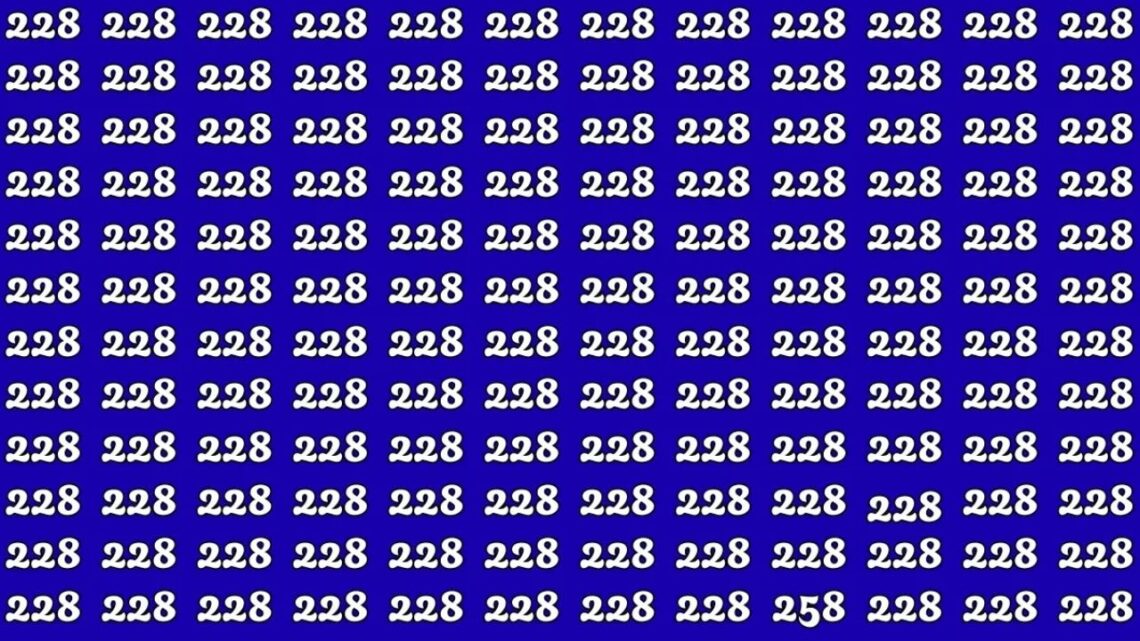Have you ever tried an optical illusion puzzle that makes your brain and eyes work together? Today’s challenge is one of those fun tests where your observation skills and focus are pushed to the limit.
You are asked to spot the number 258 hidden among many repeated numbers “228.” Sounds simple, right? But when you try, you will realize how tricky it really is.
Optical illusions are not just fun games. They also train your brain to notice details, improve your memory, and sharpen your focus. This challenge gives you only seven seconds to succeed. Let’s see if you are quick enough to find the odd number out!
The Challenge
The image for this puzzle is filled with hundreds of numbers “228” scattered on a blue background. They are placed in such a way that your eyes automatically assume all the numbers are the same. But one number is different—the hidden 258.
The real challenge is that the numbers are written in the same size and color, making it very easy for your brain to get confused. Your goal is to scan the image carefully and find where the “258” is hiding.
How to Spot the Hidden Number
If you are having trouble, don’t worry! Many people struggle with such puzzles at first. Here are some helpful tips to make it easier:
- Focus on one area at a time instead of looking at the whole picture.
- Pay attention to the middle digit. The “5” in 258 has a different shape than “2.”
- Look more closely around the bottom-left side of the image. That’s where the hidden number is located.
By moving slowly and carefully, your brain starts noticing the small differences it missed at first glance.
The Solution
If you still could not find it in seven seconds, here is the answer—the number 258 is located towards the bottom-left corner of the image. Once you see it, the difference becomes obvious, but before that, your brain tends to ignore it because of the repeating pattern.
This is why such puzzles are both challenging and entertaining.
Why Optical Illusions Trick Your Brain
The human brain is built to recognize patterns. When we see something repeating again and again, our brain saves time by assuming everything is the same. This is why you may overlook small differences.
Optical illusions like this force your mind to slow down, notice unusual details, and sharpen your focus. They are not just fun games but also good exercises for the brain. People who regularly solve such puzzles often get better at spotting mistakes, remembering details, and concentrating for longer.
Quick Facts
Here’s a simple summary of this challenge:
| Feature | Details |
|---|---|
| Challenge Type | Optical illusion puzzle |
| Numbers Shown | Mostly “228” |
| Hidden Number | 258 |
| Time Limit | 7 seconds |
| Location of 258 | Bottom-left corner |
| Skills Improved | Observation, focus, attention to detail |
This optical illusion challenge is a great way to test your observation skills and train your brain. Whether you managed to find the number “258” in under seven seconds or took a little longer, the activity helped your brain focus better. Such puzzles are enjoyable, engaging, and useful for mental sharpness.
Next time, share this challenge with your friends and family. See who among them has the sharpest eyes. You might be surprised at who finds it first! Remember, the more you practice these puzzles, the better your brain becomes at spotting hidden details in everyday life.
FAQs
Why do optical illusions feel so confusing?
Because your brain tries to save energy by following patterns, it skips over small details, making hidden differences hard to see.
Can these puzzles really improve focus?
Yes. Regular practice with puzzles like this can make you more attentive and better at noticing important details.
Where was the number 258 hidden?
It was located near the bottom-left corner of the image among many “228s.”
